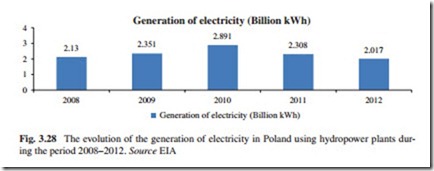Poland
The first hydropower plants in Poland were constructed in the interwar period. Those were 12 hydropower plants with a total power capacity of 18 MW. The first of them was in Z˙ ur and Gródek on the Wide River. Construction of the dam and power plant in Roz˙nów on the Dunajec River began in 1935 and they were finished in 1942.
Many other hydropower plants were built in Poland after World War II: Włocławek, Solina, and Czorsztyn-Niedzica.
At present, the technical potential of hydropower in Poland is estimated at around 13.7 TWh per year, and its current use does not exceed 12 %.
The lower Vistula (Dolna Wisła) River is of particular importance for hydro- power in Poland; around 50 % of the total technical hydropower potential is con- centrated there. The idea of using the lower Vistula River for hydropower purposes was born as early as the interwar period. Poland returned to that idea immediately after the Second World War by creating the concept of navigation and energy cas- cade on the lower Vistula River, consisting of eight low-head barrages. The only Wloclawek barrage was constructed as part of the planned cascade—it was put into operation in 1970, and is currently used inconsistently in the project.
In 2012, the total hydropower capacity installed in the country is 942 MW. This capacity installed represents 2.71 % of the total generation capacity installed in the country in 2012, and 25.6 % of the total renewables capacity installed in Poland in that year. Poland occupies the place number 78 at world level due to its hydropower capacity installed and this capacity represents 0.1 % of the world’s total. Within the European region, Poland occupies the place number 24, and the capacity installed at regional level represents 0.56 % of the total. In the past ten years, the hydropower capacity in Poland growth at an average of 0.83 % and this occurred in nine years within the period considered. The utilization of Polish technical hydropower potential does not exceed 20 % and is one of the lowest in Europe (Steller 2013).
In Poland, where thermal power plants still cover more than 96 % of the demand for electricity, until the 1990s the vast majority of storage hydropower plants operated in a peak or sub-peak regime. As a result of economic changes, which have led to changes in the daily load variation, and owing to upgrades of thermal generating sets, enabling their safe operation at variable daily loads, and to grid operators’ policy with regard to large electricity consumers, the demand for hydropower ancillary services has declined. Also, the way pumped-storage plants operate has changed. In addition, the requirements of the Ministry of Environment have forced many hydropower plants to abandon their peak operation. In some cases (Wloclawek and De˛be hydropower plants), critical relevance has been the riverbed erosion downstream of the barrage, due to the failure to build previously planned downstream barrages.
The situation in Poland, however, may soon change, as happened some time ago in many other European countries, where due to the strong development of the wind power sector and other unstable renewable energy sources the demand has increased for ancillary system services, including intervention power reserve— both in generating and electricity absorption direction. Particularly well suited for compensating the fluctuations of unstable renewable energy sources, output power is dense hydropower plant cascades and the pumped-storage plants with hydro- electric sets of variable rotation speed or operating under the hydraulic shortcut regime (concurrent operation of turbine and storage pump connected to the same penstock) (Steller 2013).
Hydropower Electricity Generation
The evolution of the generation of electricity using hydropower plants in Poland during the period 2008–2012 is shown in Fig. 3.28.
According to Fig. 3.28, the generation of electricity in Poland using hydro- power plants during the period 2008–2012 decreased 5.4 %. However, during the period 2008–2010, the generation of electricity using this type of energy source increased 10.4 %, while during the period 2010–2012 decreased 30.3 %. It is expected that the generation of electricity using this type of energy source will not change the current patterns during the coming years. The reason is that hydro- power in Poland it seems to be losing ground not only to other renewable energy sources, but also to non-renewable energy sources, the adverse environmental impact of which is indisputable.
